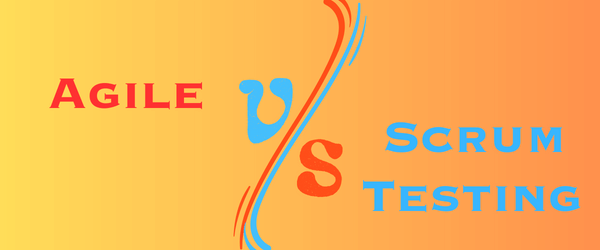Difference between Agile and Scrum TestingIn this article, we will learn the difference between Agile and Scrum testing, but let us first discuss the meaning of Agile testing and Scrum testing. 
What do you understand by Agile Testing?Agile is a software development methodology that is famous for its flexibility and the adaptability it provides. It is an iterative development methodology where requirements are made based on customer needs and through communication between teams. It is a methodology that builds the product in multiple sprints. It completes a small part of the software. After a part is completed, the part is delivered to the customer, after which the customer gives feedback, which helps improve the product. It focuses on customer requirements, so the agile team develops products as per customer requirements and feedback. It recognizes that requirements and solutions may change during the development process and encourages teams to adapt to changes. Thus, the entire product is made with as few errors as possible. Agile testing is a software testing approach that uses the values of agile methodology, which we will discuss further. If you want to be agile, then you have to follow specific values and principles. Basic Principles of Agile Testing:
Benefits of Agile Testing:
What do you understand by Scrum Testing?Scrum is a lightweight framework used in software development. It is implemented in an agile methodology to make an effective product. Developer teams work in small iterations called sprints. It basically works on a small piece of the product. Scrum testing is a testing framework used within the agile methodology to check whether the software application necessities are fulfilled. It is a collaborative approach to testing that involves a cross-functional team of developers, testers, and other stakeholders to ensure software quality. Testing is conducted throughout the development process in order to fulfill the requirements and maintain the quality of the product. The goal of scrum testing is to detect faults early in the development process, which helps decrease the cost and time needed to fix them. The scrum testing process includes the steps discussed below: Sprint Planning: In this step, the team discusses the test requirements and customer needs, then makes a test plan. Daily Scrum: In this step, team members discuss product progress daily, check for difficulties, and plan testing activities for the day. Sprint Review: In this step, the team shows the working part of the product to the stakeholders and collects feedback. The testing team review and identify the defects. Sprint Retrospective: In this step, the team examines the changes and improvements the sprint needs to make. The testing team provides feedback on the testing process and presents ways to improve it. Benefits of Scrum Testing:
The key differences between Agile and Scrum Testing are as follows:
Conclusion:In this article, you have studied the difference between Agile and Scrum testing in which you have understood that Agile testing is a methodology that creates software in multiple sprints. It continuously tests the product and receives feedback from customers. In contrast, scrum testing is the framework used to implement the principles of agile methodology. The main difference between Agile and Scrum testing is that agile testing uses a set of principles to provide the best quality product to the customers, whereas scrum testing is the testing framework that uses the agile methodology to provide the best quality product to the customers.
Next TopicDifference Between
|
 For Videos Join Our Youtube Channel: Join Now
For Videos Join Our Youtube Channel: Join Now
Feedback
- Send your Feedback to [email protected]
Help Others, Please Share










